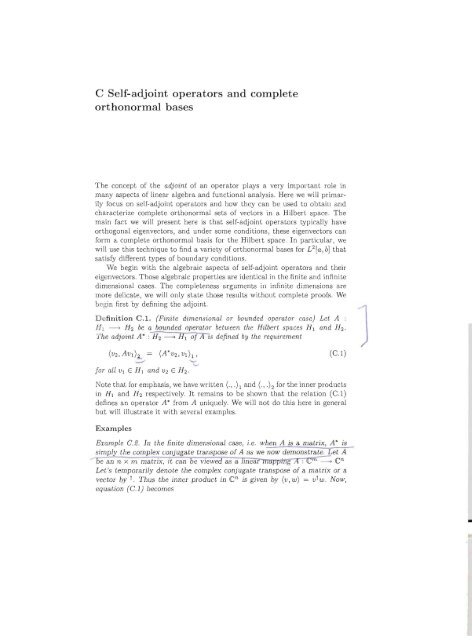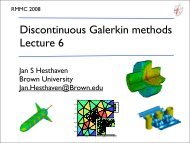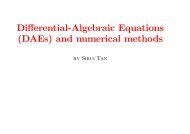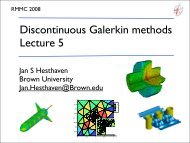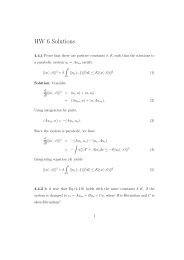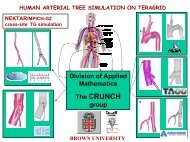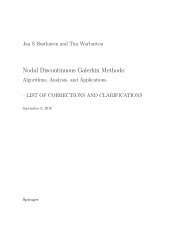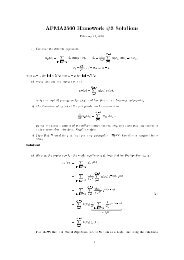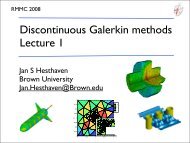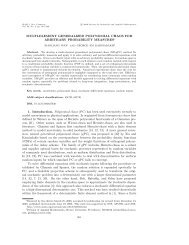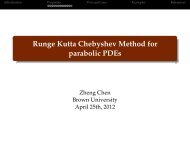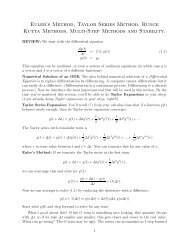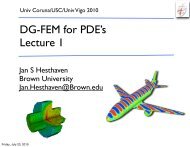Read here about Self-Adjoint Operators
Read here about Self-Adjoint Operators
Read here about Self-Adjoint Operators
You also want an ePaper? Increase the reach of your titles
YUMPU automatically turns print PDFs into web optimized ePapers that Google loves.
C <strong>Self</strong>-adjoint operators and complete<br />
orthonormal bases<br />
The concept of the adjoint of an operator plays a very important role in<br />
many aspects of linear algebra and functional analysis. Here we will primarily<br />
focus on s e ll~adjoint operators and how they can be used to obtain and<br />
characterize complete orthonormal sets of vectors in a Hilbert space. The<br />
main fact we will present <strong>here</strong> is that self-adjoint operators typically have<br />
orthogonal eigenvectors, and under some conditions, these eigenvectors can<br />
form a complete orthonormal basis for the Hilbert space. In particular, we<br />
will use this technique to find a variety of orthonormal bases for L2 [a, b] that<br />
satisfy different types of boundary conditions.<br />
We begin with the algebraic aspects of self-adjoint operators and their<br />
eigenvectors. Those algebraic properties are identical in the finite and infinite<br />
dimensional cases. The completeness arguments in infinite dimensions are<br />
more delicate, we will only state those results without complete proofs. We<br />
begin first by defining the adjoint.<br />
D efinition C.l. (Finite dimensional or bounded operator case) Let A<br />
H I -; H2 be a bounded operator between the Hilbert spaces HI and H 2.<br />
The adjomt A' : H2 ---; HI of Xis defined by the req1Lirement<br />
(V2, AVI ) ~ = (A''V2, v])], (C.l)<br />
---<br />
fOT all VI E HI and'V2 E H2·<br />
Note that for emphasis, we have written (. , .)] and (. , ')2 for the inner products<br />
in HI and H2 respectively. It remains to be shown that the relation (C.l)<br />
defines an operator A' from A uniquely. We will not do this <strong>here</strong> in general<br />
but will illustrate it with several examples.<br />
J<br />
Examples<br />
Example C. 2. In the finite dimensional case, i.e. when A is a matrix, A' is<br />
simply the c;omplex c;onjugate transpose of A as' we now demonstrate. Let A<br />
be an n x m matrix, it can be viewed as a lJJ1ear illap')1~ en<br />
Let 's temporarily denote the complex conjugate transpose of a matrix or a<br />
vector by 1. ThuS' the inner product in en is' given by (v ,w) = vtw. Now,<br />
equation (G.l) becomes<br />
-
72 C <strong>Self</strong>-adjoint. operators and complete orthonormal bases<br />
for all vectors Vj and V2 This in tum implies that A (A*)t or equivalently<br />
that<br />
i.e. the adjoint of a matrix is the complex conjugate transpose of that matrix.<br />
Example C.S. Let T : L2[a, b] ---; L 2 [a, b] be the bounded operator defined<br />
'bythe continuous kernel function T(.,.) Specifically, T : f r-; 9 is given by<br />
g(x) =<br />
lb T(r,x) f(x) dx.<br />
We compute the kernel representation ofT* which we will denote by T* (., .).<br />
Translating the requirement (G.]) using the inner product of L2[0. , b] gives<br />
(h, Tf) = (rh, f)<br />
~<br />
lb ht(x) (TIl (x) d.T = lb ((T*h) (1')) Tf(1') dr,<br />
w<strong>here</strong> again (.)t denotes complex conjugate transpose. Substituting the kernel<br />
represent;ations for T and T*, we obtain<br />
lb ht(x) (lJ T(x,X) f(x) dX) dx =lb (l b<br />
r(1',p) h(p) dP) t f(1') dr<br />
~<br />
lb lb ht(:.r) T(r,x) f(x) dXd:.r = lb lJ ht(p) (T*(r,p))t f(r) drdp,<br />
which can then be rewritten as<br />
This last equation has to hold for all functions hand f in L2 [0., b]. By using<br />
test functions (see problem G.15) for f and h, it is not difficult to verify that<br />
the kernels satisfy T(.T,X) = (T*(x,r)r Taking transposes of both sides<br />
and relabeling the arguments x and X we can then write<br />
T*(r,x) = Tt(X,x).<br />
Note the interesting pattern <strong>here</strong>; the kernel T* (., .) is given by "transposing"<br />
the arguments of the kernel T(.,.) and taking the complex conjugate<br />
transpose at each point. This result is consistent with the interpretation of<br />
kernel functions as continuum analogues of matrices (see Appendix B).
C <strong>Self</strong>-adjoint operators and complete orthonormal bases<br />
73<br />
For the proper defini tion of the adjoint in the unbounded operator case,<br />
domain considerations are important.<br />
Definition C.4. (Unbounded operator case) Let A . HI --+ H2 be an operator<br />
between the Hilbert spaces H I and H2 with domain D(A) C HI . The<br />
adjoint A* : H2 --+ HI of A is defined by the requirement<br />
(C.2)<br />
for all VI E D(A) and V2 for which it is finite. The set of such vectors V2 is<br />
the domain D(A*) C H2 of A*<br />
Examples<br />
Example C.S. Consider the following differential operator on L2[a , bj<br />
d<br />
D := - ,<br />
dx<br />
For f E D(D) and 9 E L2, we evaluate (g , D J) and use integration by parts<br />
to obtain<br />
r b<br />
df<br />
(g,D/) = Ja gt(x) dx (x) dx<br />
(C.3)<br />
= g(x) f(x)l~<br />
r b dg t<br />
- Ja dx (x)f(x) dx (C.4)<br />
=g(b)f(b) - (:x9,f). (C.5)<br />
Thus it is clear that for (G.2) to hold, D' must be given by<br />
D* = - ~<br />
dx '<br />
Note the difference between the domains of D and D*.<br />
Example e.C. Consider Llo, the second order derivative operator with homogenous<br />
Dirichlet boundary conditions defined on L2 [a, bj by<br />
For f E D(Llo) and 9 E L2, we evaluate l<br />
1 Here we use the notation l' and f" for the first and second derivatives of a<br />
function f respectively
74 C <strong>Self</strong>-adjoint operi1tors and complet.e orthonormal bases<br />
bgt<br />
(g,.d.of) = 1 (X) f"(x) dx (C.6)<br />
= g(x))' (x) I~ 1b g't (x)/, (x) dx (C.7)<br />
== g(x)!,(x)l~ g'(x)J(x) l ~ + 1b gilt (x)f(x) dx (C.B)<br />
== gJi/' (b)l~ + \ d~2 g, f) .<br />
(C.g)<br />
Thus for (G.2) to hold, .d.o must be defined as ~ on the domain of twice<br />
differentiable functions 9 E L2 with g(a) = g(b) = O. This is precisely the<br />
same definition and domain as .d.o , and we t<strong>here</strong>fore conclude<br />
We have concluded that .d. o is equal to its adjoint. Such operators are called<br />
self-adjoin t.<br />
<strong>Self</strong>-adjoint operators<br />
Definition C.7. Let A be an operator from a dense domain D(A)
C <strong>Self</strong>-adjoint operators and complete orthonormal bases<br />
75<br />
In the case of repeated eigenvalues, one can still make statements similar<br />
to the ones above. If A has two linearly independent eigenvectors w, v with<br />
the same eigenvalue A, then any vector in the two dimensional subspace<br />
spanned by {w ,v} is an eigenvector with eigenvalue A. In this case, we can<br />
pick two orthonormal vectors in that space that span it. This procedure can<br />
be applied to eigenvalues of any mUlitplicity. The resulL is Lhat we can choose<br />
a complete orthonormal basis from amongst the eigenvectors of a self-adjoint<br />
adjoint operator. The precise statement follows, though its complete proof is<br />
not given <strong>here</strong>.<br />
Theorem C.g. Let A be a self adJoint operator defined on a dense domain ]<br />
in a Hilbert space H. Tf A has a discrete spectrl1m, then ther'c exists an orthonormal<br />
set of eigen'uectors of A thal span all of H.<br />
This result is normally used to construct bases for function spaces lLke [2(X)<br />
that satisfy certain boundary conditions. To do this, one must be able to<br />
construct a self-adjoint operator whose domain is specified uy those boundary<br />
conditions. This is only possible for certain kinds of boundary conditions. We<br />
illustrat.e this technique wiLh two examples.<br />
Example C.10. Consider the operator LJ.D described in exa.mple 0.6. This operator<br />
is self-adjoint as demonstrated in that example. We now determine its<br />
spectrum. If it turns out to be discrete, then we can use the eigenfunctions as<br />
a complete orthogonal basis o[ L2[a, b] which have the property o[ being zero<br />
at the boundary points Q. and b. For computational simplicity, let's consider<br />
the problem over [2r-1f , 1f] tbough the procedure is applicable to any finite<br />
interval.<br />
A non-zero function ¢ E L2 [_ 1f, 1f] is an eigenfunction of LJ.D if¢(± 1f) = 0<br />
(i.e. it is in V(LJ.D )) and LJ.D¢ = A¢ or equivalently<br />
d 2 <br />
-d2 ¢(x) = A¢(X), q'J(± 1f) = O. <br />
:r<br />
This is a second order ODE with constant coefficients. it may not have solutions<br />
that satisfy the boundary conditions [or all A. We first characterize<br />
the numbers A [or which t<strong>here</strong> exists soluiions, and then construci those solutions.<br />
The characteristic roots are given as the roots of the polynomial (in<br />
0) (a 2 - A) = O. The form of the solutions depends on whether A is positive<br />
or negative, they are<br />
¢(x) == ae~ r + /; e -~r ifA >O, <br />
¢(x) = acos(.Jf,\! x) + b sin(.Jf,\! x)<br />
i[ A < O. <br />
We first note that the case A > 0 can not satisfy the given boundary cOllditions<br />
since in that case<br />
o = ¢(1f) = a e"~ + b e -"~<br />
o = ¢(-1f) = a e -" ~ + b e"~
76 C <strong>Self</strong>-adjoint operators and complet.e orthonormal bases<br />
for which the only solution is a :=: b = O. Now, considering the case).. < 0, we<br />
need to satisfy<br />
0= o.cos(1fM) + bsin(1fM)<br />
0 = o.cos(-1fM) + bsin(-1fM).<br />
The existence of a nonzero pair (a, b) that satisfy the above is equivalent to<br />
which is equivalent to<br />
This means that 21fM = i1f, w<strong>here</strong> i = 1,2, .... From this we conclude<br />
that the set of ).. < 0 for which we can satisfy the boundwy conditions is<br />
given by<br />
i = 1,2,<br />
Thus we have found the eigenvalues of ,do and they indeed Form a discrete<br />
set. The corresponding eigenfunctions are given by<br />
i<br />
i<br />
-<br />
C <strong>Self</strong>-adjoinl operators a.nd complete orthonormal bases 77<br />
Example C.lI. In this examplc, we would like to construct a self-adjoint<br />
operator whose domain is specified by some given boundary conditions. Once<br />
such all opeTator is constructed, its eigenfunctions will then give the desired<br />
orthonormal basis.<br />
Suppose we would like to find an orthonormal basis {cp,} for L2 [- 1,1]<br />
such that<br />
CPi(±1) = 0, dcp (±1) = O. (C.lD)<br />
dx<br />
One way to achieve this is to construct a. self-adjoint operator on L2 [-1, 1]<br />
whose domain is given by those boundary conditions. Since we have four<br />
boundary conditions, said operator will need to be a fourth order differential<br />
operator. The general form of a fourth order differentia.l operator with<br />
constant coefficients is<br />
w<strong>here</strong> for simplicity of nota/jon we use D := d~' As shown in Problem G16,<br />
a necessalY condition for A to be self~adjoint is that it contains only even<br />
order terms, hence a.3 = a] = O. We investigate whether a pure fourth order<br />
term by itself is sufficient. From Problem C.16 we can state<br />
By inspecting the bounda.ry terms, we see tha.t if f is such that f (±1)<br />
J'(±1) = 0, then for all functions 9 with g(±1) = g'(±1) = 0 we get that<br />
(g, D4 f) = (D4 g,f). This implies that if we define<br />
then it follows that A* = dd:', and that V(A*) =V(A). The reader is asked to<br />
verify this carefully as an exercise. We have thus found a self-adjoint operator<br />
whose domain is given by the desired boundary conditions (Gl0). To find the<br />
eigenvalues of A, one needs to find the real values A for which the equation<br />
d'l<br />
dq;<br />
dx 4<br />
cp(x) - Acp(X) = 0, CPi(± l) = -(±l) = 0,<br />
dx<br />
has a solution. Those values turn out to form a discrete set. The eigenfunctions<br />
are then fOllnd by solving the differential equation at those values of<br />
A. A complete orthogonal basis for L2 [- 1, 1] satisfying the boundary conditions<br />
(GIG) is thus obtained.


